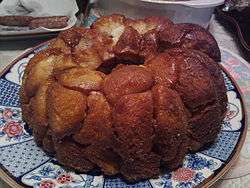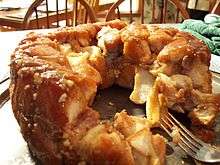Monkey bread
Monkey bread (also known by other names including pull-apart bread and bubble bread)[2] is a soft, sweet, sticky pastry served in the United States for breakfast or as a treat. It consists of pieces of soft baked dough sprinkled with cinnamon. It is often served at fairs and festivals.[3]
 | |||||||
| Alternative names | Pull-apart bread, bubble bread, Christmas morning delights | ||||||
|---|---|---|---|---|---|---|---|
| Type | Bread or pastry | ||||||
| Course | Breakfast | ||||||
| Place of origin | Hungary | ||||||
| Serving temperature | baked at 175 degrees Celsius (350 degrees Fahrenheit), then left 10 minutes to cool | ||||||
| Main ingredients | bread flour[1] | ||||||
| 352 kcal (1474 kJ) | |||||||
| |||||||
Name

The origin of the term "monkey bread" comes from the pastry being a finger food; the consumer would pick apart the bread as a monkey would.[2]
Other names for the bread include Christmas morning delights,[2] monkey puzzle bread, monkey brains, sticky bread, Hungarian coffee cake, golden dumpling coffee cake, pinch-me cake, pluck-it cake, bubble loaf and funky bread.
Origins
What most people know as monkey bread today in the United States is actually the Hungarian dessert arany galuska ("golden dumpling"). Dating back to the 1880s in Hungarian literature, Hungarian immigrants brought this dish with them when they immigrated to America and began introducing it into the country's food landscape when Hungarian and Hungarian Jewish bakeries began selling it in the mid-twentieth century.
In 1972, a cookbook published by Betty Crocker included a recipe for arany galuska, which they referred to as "Hungarian Coffee Cake". As it became more popular in America, arany galuska came to be confused with monkey bread in which the balls of dough are not dipped in cinnamon and sugar but only in butter. "Monkey bread" soon became the more common name for this Hungarian Jewish dessert.[4]
Recipes for the bread first appeared in American women's magazines and community cookbooks in the 1950s, but the dish is still virtually unknown outside the United States.
Preparation
The bread is made with pieces of sweet yeast dough (often frozen), which are baked in a cake pan at high heat after first being individually covered in melted butter, cinnamon, sugar, and chopped pecans.[5] It is traditionally served hot so that the baked segments can be easily torn away with the fingers and eaten by hand.[6]
See also
References
- "Monkey bread recipe". taste.com.au. 7 July 2015.
- Olver, Lynne. "The Food Timeline: history notes". The Food Timeline. Retrieved October 4, 2008.
- "House of the Rising Bun". Good Eats. Season 10. Episode EA1003. April 7, 2006. Food Network.
- Gil Marks (17 November 2010). Encyclopedia of Jewish Food. HMH. ISBN 978-0-544-18631-6.
- Brown, Alton (2006). "Overnight Monkey Bread". "Good Eats" Recipes. Food Network. Archived from the original on September 20, 2007. Retrieved September 10, 2007.
- Boodro, Michael (2003). "Just Say Dough". "FOOD" Magazine. The New York Times Company. Retrieved 2016-09-11.